by Calculated Risk on 8/16/2018 11:01:00 AM
Thursday, August 16, 2018
Comments on July Housing Starts
Earlier: Housing Starts at 1.168 Million Annual Rate in July
Housing starts in July were disappointing once again, and starts for May and June were revised down. However this was just the second month of disappointing starts, and most of the decline was in multi-family starts that are volatile month-to-month.
The housing starts report released this morning showed starts were up 0.9% in July compared to June (only up because June was revised down), and starts were down 1.4% year-over-year compared to July 2017.
Multi-family starts were down 9.6% year-over-year, and single family starts were up 2.7% year-over-year.
This first graph shows the month to month comparison for total starts between 2017 (blue) and 2018 (red).
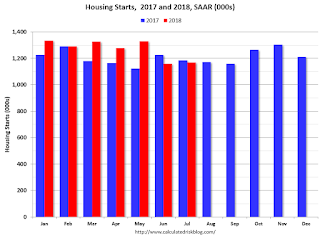
Starts were down 1.4% in July compared to July 2017.
Through seven months, starts are up 6.2% year-to-date compared to the same period in 2017. Even with the weakness over the last two months, that is still a decent increase.
Single family starts were up 2.7% year-over-year, and up 0.9% compared to July 2018.
Multi-family starts were down 9.6% year-over-year, and up 3.1% compared to June 2018 (multi-family is volatile month-to-month).
Below is an update to the graph comparing multi-family starts and completions. Since it usually takes over a year on average to complete a multi-family project, there is a lag between multi-family starts and completions. Completions are important because that is new supply added to the market, and starts are important because that is future new supply (units under construction is also important for employment).
These graphs use a 12 month rolling total for NSA starts and completions.
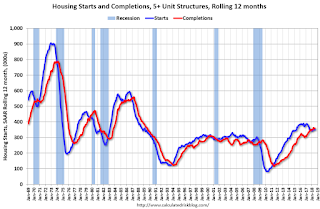
The rolling 12 month total for starts (blue line) increased steadily for several years following the great recession - but has turned down recently. Completions (red line) had lagged behind - however completions have passed starts (more deliveries).
It is likely that both starts and completions, on rolling 12 months basis, will now move mostly sideways.
As I've been noting for a few years, the significantly growth in multi-family starts is behind us - multi-family starts peaked in June 2015 (at 510 thousand SAAR).

Note the relatively low level of single family starts and completions. The "wide bottom" was what I was forecasting following the recession, and now I expect a couple more years, or more, of increasing single family starts and completions.
Note: Last month, in response to numerous articles discussing the "slowing housing market" and some suggesting "housing has peaked", I wrote: Has Housing Market Activity Peaked? and Has the Housing Market Peaked? (Part 2). My view currently remains the same, but if the weakness in housing starts and new home sales persist, I'll revisit my outlook. My guess is the weakness will not continue, and new home sales and single family starts will increase further.
MBA: Mortgage Delinquency Rate decreased in Q2
by Calculated Risk on 8/16/2018 10:34:00 AM
From the MBA: Mortgage Delinquencies Down in 2nd Quarter of 2018
The delinquency rate for mortgage loans on one-to-four-unit residential properties fell to a seasonally adjusted rate of 4.36 percent of all loans outstanding at the end of the second quarter of 2018.
The delinquency rate was down 27 basis points from the previous quarter, but was up 12 basis points from one year ago, according to the Mortgage Bankers Association’s (MBA) National Delinquency Survey. The percentage of loans on which foreclosure actions were started dropped four basis points from the last quarter to 0.24 percent, its lowest level since the second quarter of 1987.
“We continue to see improvement in the overall mortgage delinquency rate as the impact of the hurricanes from one year ago lessens, particularly for conventional loans,” according to Marina Walsh, Vice President of Industry Analysis at MBA. “Among the various loan types, the delinquency rate for conventional loans was two basis points lower than one year ago, prior to the hurricanes. While delinquencies for both FHA and VA loans were up from one year ago, they were improved over the previous quarter.”
...
Mortgage delinquencies dropped across all stages of delinquency in the second quarter of 2018 compared to the first quarter of 2018. The 30-day delinquency rate dropped two basis points from the previous quarter, while the 60-day and 90-day delinquency buckets dropped by eight and 18 basis points respectively.
...
The delinquency rate includes loans that are at least one payment past due but does not include loans in the process of foreclosure. The percentage of loans in the foreclosure process at the end of the second quarter was 1.05 percent, down 11 basis points from the first quarter of 2018 and 24 basis points lower than one year ago. This was the lowest foreclosure inventory rate since the third quarter of 2006.
...
The serious delinquency rate, the percentage of loans that are 90 days or more past due or in the process of foreclosure, was 2.30 percent in the second quarter of 2018, a decrease of 31 basis points from last quarter, and a decrease of 19 basis points from last year.
emphasis added
 Click on graph for larger image.
Click on graph for larger image.This graph shows the percent of loans delinquent by days past due.
The percent of loans delinquent decreased in Q2, as "the impact of the hurricanes from one year ago lessens".
The percent of loans in the foreclosure process continues to decline, and is close to normal levels.
Housing Starts at 1.168 Million Annual Rate in July
by Calculated Risk on 8/16/2018 08:40:00 AM
From the Census Bureau: Permits, Starts and Completions
Housing Starts:
Privately-owned housing starts in July were at a seasonally adjusted annual rate of 1,168,000. This is 0.9 percent above the revised June estimate of 1,158,000, but is 1.4 percent below the July 2017 rate of 1,185,000. Single-family housing starts in July were at a rate of 862,000; this is 0.9 percent above the revised June figure of 854,000. The July rate for units in buildings with five units or more was 303,000.
Building Permits:
Privately-owned housing units authorized by building permits in July were at a seasonally adjusted annual rate of 1,311,000. This is 1.5 percent above the revised June rate of 1,292,000 and is 4.2 percent above the July 2017 rate of 1,258,000. Single-family authorizations in July were at a rate of 869,000; this is 1.9 percent above the revised June figure of 853,000. Authorizations of units in buildings with five units or more were at a rate of 410,000 in July.
emphasis added
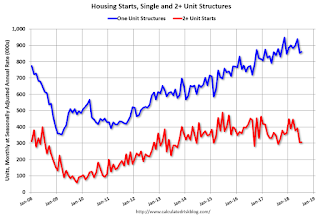 Click on graph for larger image.
Click on graph for larger image.The first graph shows single and multi-family housing starts for the last several years.
Multi-family starts (red, 2+ units) increased slightly in July compared to June. Multi-family starts were down 12% year-over-year in July.
Multi-family is volatile month-to-month, and has been mostly moving sideways the last few years. This is the bottom of the range.
Single-family starts (blue) increased in July, and were up 2.7% year-over-year.
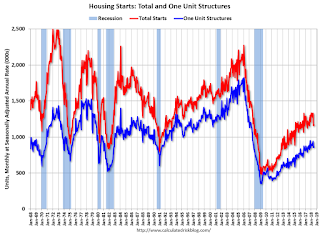 The second graph shows total and single unit starts since 1968.
The second graph shows total and single unit starts since 1968. The second graph shows the huge collapse following the housing bubble, and then - after moving sideways for a couple of years - housing is now recovering (but still historically fairly low).
Total housing starts in July were well below expectations, and starts for May and June were both revised down.
I'll have more later ...
Weekly Initial Unemployment Claims decreased to 212,000
by Calculated Risk on 8/16/2018 08:33:00 AM
The DOL reported:
In the week ending August 11, the advance figure for seasonally adjusted initial claims was 212,000, a decrease of 2,000 from the previous week's revised level. The previous week's level was revised up by 1,000 from 213,000 to 214,000. The 4-week moving average was 215,500, an increase of 1,000 from the previous week's revised average. The previous week's average was revised up by 250 from 214,250 to 214,500.The previous week was revised up.
emphasis added
The following graph shows the 4-week moving average of weekly claims since 1971.
 Click on graph for larger image.
Click on graph for larger image.The dashed line on the graph is the current 4-week average. The four-week average of weekly unemployment claims increased to 215,500.
This was lower than the consensus forecast. The low level of claims suggest few layoffs.
Wednesday, August 15, 2018
Thursday: Housing Starts, Unemployment Claims, Philly Fed Mfg
by Calculated Risk on 8/15/2018 06:51:00 PM
Thursday:
• At 8:30 AM ET, Housing Starts for July. The consensus is for 1.271 million SAAR, up from 1.173 million SAAR.
• Also at 8:30 AM, The initial weekly unemployment claims report will be released. The consensus is for 215 thousand initial claims, up from 213 thousand the previous week.
• Also at 8:30 AM, the Philly Fed manufacturing survey for August. The consensus is for a reading of 22.3, down from 25.7.
LA area Port Traffic Mostly Unchanged YoY in July
by Calculated Risk on 8/15/2018 01:41:00 PM
Container traffic gives us an idea about the volume of goods being exported and imported - and usually some hints about the trade report since LA area ports handle about 40% of the nation's container port traffic.
The following graphs are for inbound and outbound traffic at the ports of Los Angeles and Long Beach in TEUs (TEUs: 20-foot equivalent units or 20-foot-long cargo container).
To remove the strong seasonal component for inbound traffic, the first graph shows the rolling 12 month average.
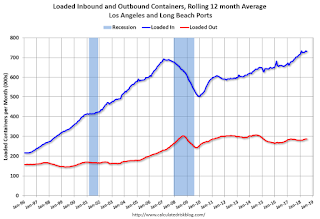
On a rolling 12 month basis, inbound traffic was down 0.1% compared to the rolling 12 months ending in June. Outbound traffic was up 0.2% compared to the rolling 12 months ending in June.
The 2nd graph is the monthly data (with a strong seasonal pattern for imports).

In general imports have been increasing, and exports have mostly moved sideways over the last 6 or 7 years.
It is still too early to tell about the impact of the tariffs.
Earlier from the NY Fed: Manufacturing "Business activity remained robust in New York State"
by Calculated Risk on 8/15/2018 01:11:00 PM
From the NY Fed: Empire State Manufacturing Survey
Business activity remained robust in New York State, according to firms responding to the August 2018 Empire State Manufacturing Survey. The headline general business conditions index climbed three points to 25.6. New orders and shipments grew strongly, and firms reported an increase in unfilled orders. Delivery times continued to lengthen, and inventories held steady. Labor market indicators pointed to solid gains in employment and longer workweeks. Price indexes were little changed and remained elevated, indicating ongoing significant price increases. Looking ahead, firms stepped up their capital spending plans and were fairly optimistic about the six-month outlook.This was above the consensus forecast and a solid reading.
…
The index for number of employees edged lower, but at 13.1, pointed to a pickup in employment levels. The average workweek index was 8.9, indicating a modest increase in hours worked.
emphasis added
NAHB: Builder Confidence declines to 67 in August
by Calculated Risk on 8/15/2018 10:07:00 AM
The National Association of Home Builders (NAHB) reported the housing market index (HMI) was at 67 in August, down from 68 in July. Any number above 50 indicates that more builders view sales conditions as good than poor.
From NAHB: Builder Confidence Remains Firm in August
Builder confidence in the market for newly-built single-family homes edged down one point to a solid 67 reading in August on the National Association of Home Builders/Wells Fargo Housing Market Index (HMI).
“The good news is that builders continue to report strong demand for new housing, fueled by steady job and income growth along with rising household formations,” said NAHB Chairman Randy Noel, a custom home builder from LaPlace, La. “However, they are increasingly focused on growing affordability concerns, stemming from rising construction costs, shortages of skilled labor and a dearth of buildable lots.”
“The solid economic expansion and firm job market should spur demand for new single-family homes in the months ahead,” said NAHB Chief Economist Robert Dietz. “Meanwhile, builders continue to monitor how tariffs and the growing threat of a trade war are affecting key building material prices, including lumber. These cost increases, coupled with rising interest rates, are putting upward pressure on home prices and contributing to growing affordability challenges, as indicated by the latest quarterly reading of the NAHB/Wells Fargo Housing Opportunity Index.”
...
The HMI index measuring current sales conditions inched one point lower to 73 while the component gauging expectations in the next six months all fell a single point to 72. Meanwhile, the metric charting buyer traffic dropped two points to 49.
Looking at the three-month moving averages for regional HMI scores, the South and West each held steady at 70 and 75, respectively. The Northeast fell three points to 54 and the Midwest also posted a three-point decline to stand at 62.
emphasis added
 Click on graph for larger image.
Click on graph for larger image.This graph show the NAHB index since Jan 1985.
This was below the consensus forecast, but still a solid reading.
Industrial Production Increased 0.1% in July
by Calculated Risk on 8/15/2018 09:22:00 AM
From the Fed: Industrial Production and Capacity Utilization
Industrial production edged up 0.1 percent in July after rising at an average pace of 0.5 percent over the previous five months. Manufacturing production increased 0.3 percent, the output of utilities moved down 0.5 percent, and, after posting five consecutive months of growth, the index for mining declined 0.3 percent. At 108.0 percent of its 2012 average, total industrial production was 4.2 percent higher in July than it was a year earlier. Capacity utilization for the industrial sector was unchanged in July at 78.1 percent, a rate that is 1.7 percentage points below its long-run (1972–2017) average.
emphasis added
 Click on graph for larger image.
Click on graph for larger image.This graph shows Capacity Utilization. This series is up 11.4 percentage points from the record low set in June 2009 (the series starts in 1967).
Capacity utilization at 78.1% is 1.7% below the average from 1972 to 2017 and below the pre-recession level of 80.8% in December 2007.
Note: y-axis doesn't start at zero to better show the change.
 The second graph shows industrial production since 1967.
The second graph shows industrial production since 1967.Industrial production increased in July to 107.3. This is 24% above the recession low, and 2% above the pre-recession peak.
This was below the consensus forecast, however production for June was revised up.
Retail Sales increased 0.5% in July
by Calculated Risk on 8/15/2018 08:37:00 AM
On a monthly basis, retail sales increased 0.5 percent from June to July (seasonally adjusted), and sales were up 6.4 percent from July 2017.
From the Census Bureau report:
Advance estimates of U.S. retail and food services sales for July 2018, adjusted for seasonal variation and holiday and trading-day differences, but not for price changes, were $507.5 billion, an increase of 0.5 percent from the previous month, and 6.4 percent above July 2017. Total sales for the May 2018 through July 2018 period were up 6.3 percent from the same period a year ago. The May 2018 to June 2018 percent change was revised from up 0.5 percent to up 0.2 percent.
 Click on graph for larger image.
Click on graph for larger image.This graph shows retail sales since 1992. This is monthly retail sales and food service, seasonally adjusted (total and ex-gasoline).
Retail sales ex-gasoline were up 0.5% in July.
The second graph shows the year-over-year change in retail sales and food service (ex-gasoline) since 1993.
 Retail and Food service sales, ex-gasoline, increased by 5.1% on a YoY basis.
Retail and Food service sales, ex-gasoline, increased by 5.1% on a YoY basis.The increase in July was above expectations, however sales in May and June were revised down.


